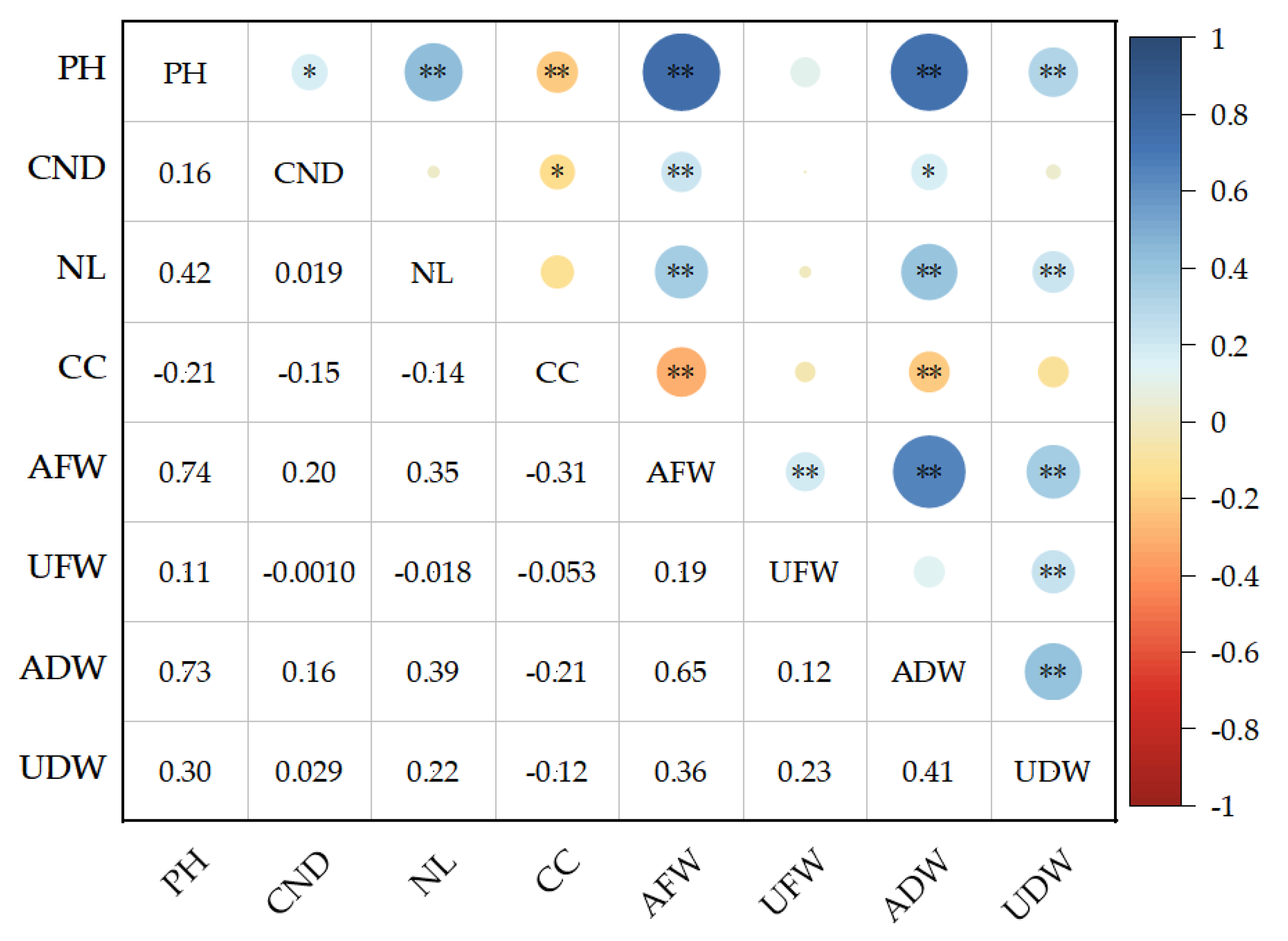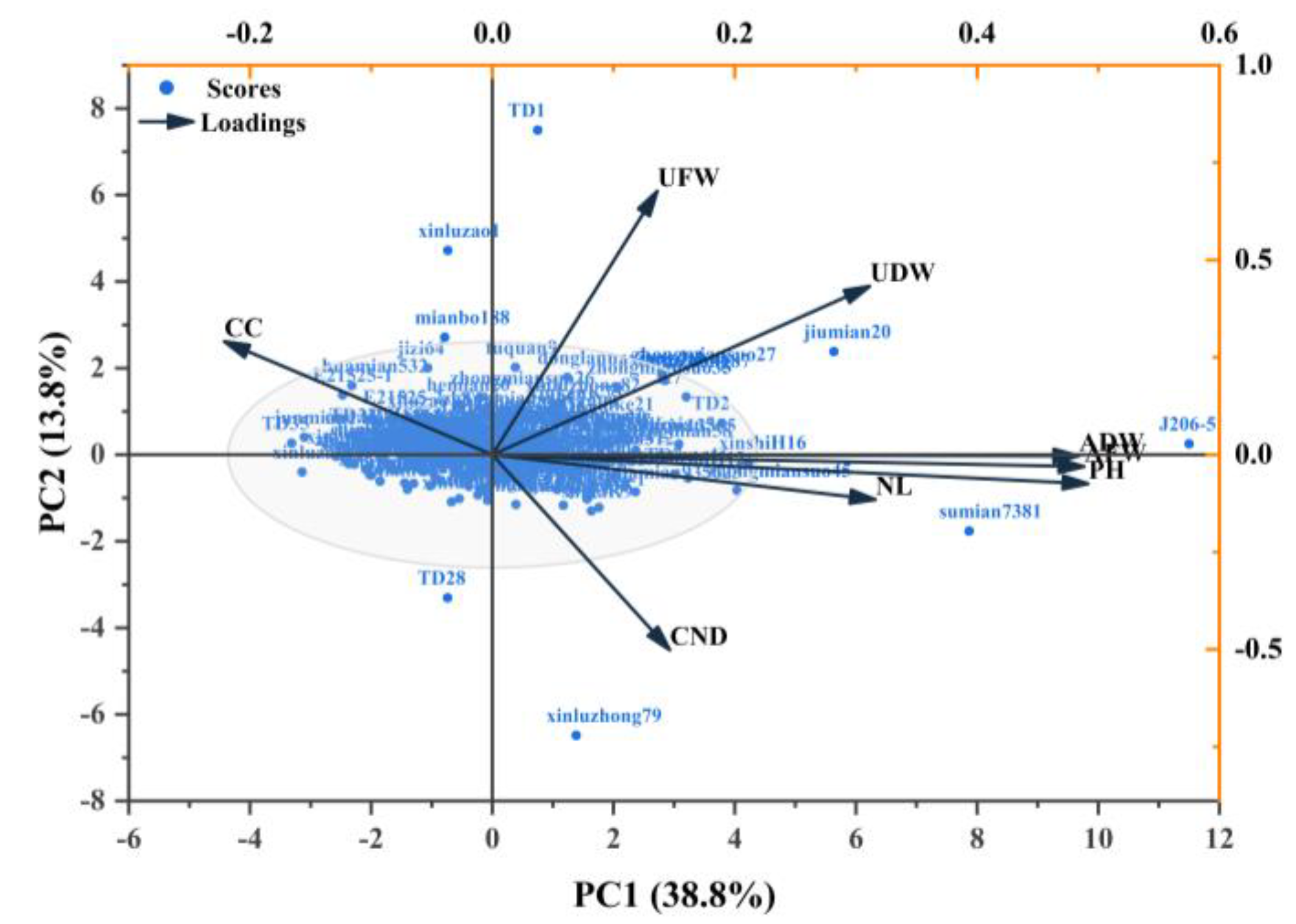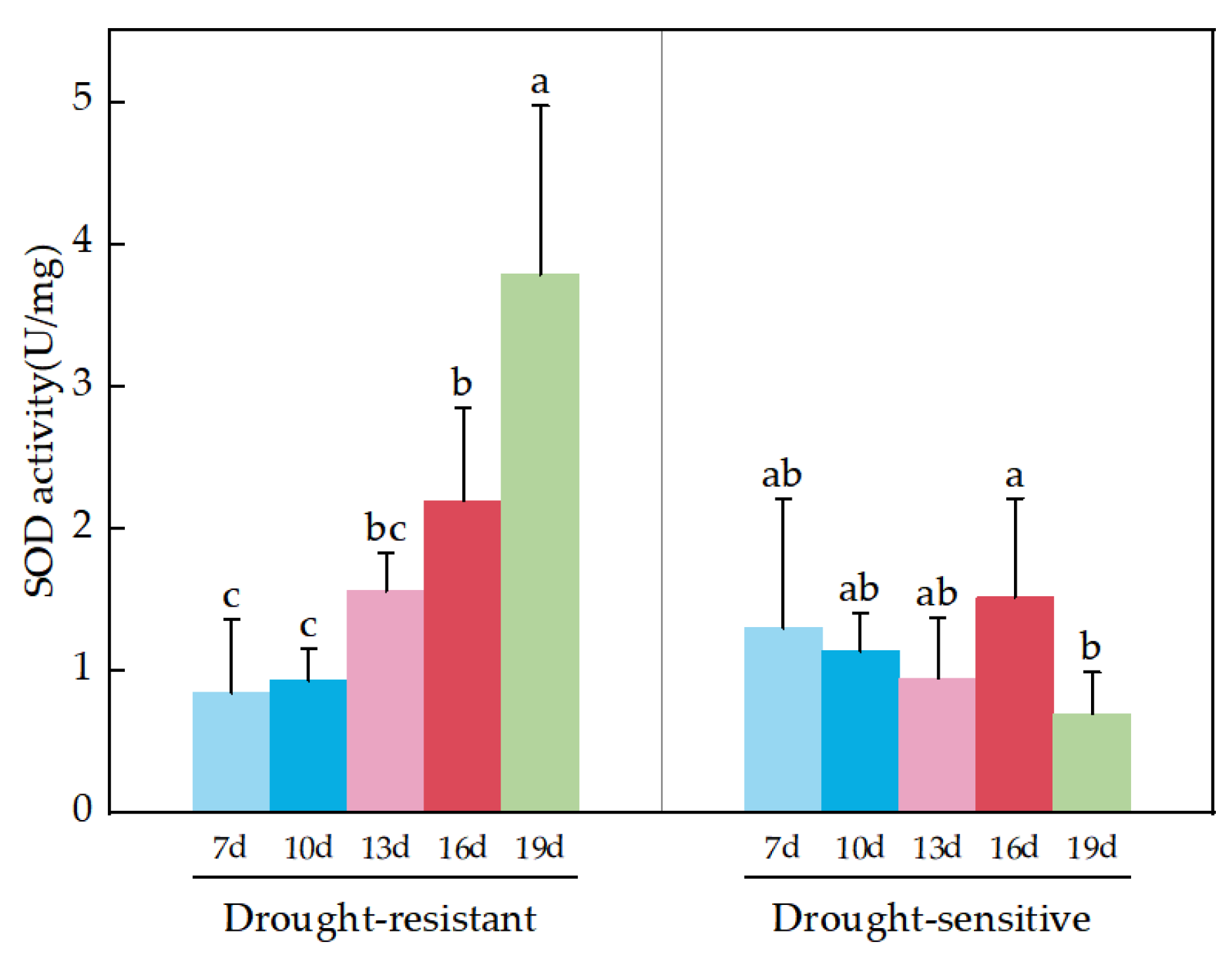Comprehensive Evaluation of 202 Cotton Varieties (Lines) and Their Physiological Drought Resistance Response During Seedling Stage
Abstract
1. Introduction
2. Results
2.1. Analysis of Drought Resistance of 202 Cotton Varieties (Lines)
2.1.1. Statistical Analysis of Drought Resistance Coefficient (Dc)
2.1.2. ANOVA and Correlation Analysis of Eight Traits
2.1.3. Principal Component Analysis of Drought Resistance Coefficient for Eight Traits
2.1.4. Partial Correlation Analysis Between Drought Resistance Coefficient and D-Value of Eight Traits
2.1.5. D-Value Analysis of 202 Cotton Varieties (Lines)
2.2. Analysis of Physiological Indicators Under Drought Stress
2.2.1. Analysis of SOD (Drought Stress/Control) Under Drought Stress
2.2.2. Pro (Drought Stress/Control) Analysis Under Drought Stress
2.2.3. MDA (Drought Stress/Control) Analysis Under Drought Stress
3. Discussion
3.1. Screening and Comprehensive Evaluation of Drought Resistance Morphological Traits in Cotton Seedling
3.2. Characteristics of Physiological Indicators in Cotton Seedling Under Drought Stress
4. Conclusions
5. Materials and Methods
5.1. Materials
5.2. Methods
5.3. Comprehensive Evaluation of Drought Resistance
- (1)
- Calculate the drought resistance coefficient (Dc) according to formula (1):
- (2)
- Standardization of various traits: Standardize the positive and negative traits according to formulas 2 and 3, respectively.
- (3)
- Data translation processing: To ensure the validity of the values, add 0.01 to each standardized number.
- (4)
- Calculate the proportion (Pij) of the j-th trait of the i-th variety (line) according to formula (4):
- (5)
- Calculate the entropy value (ej) of each trait according to formula (5):
- (6)
- Calculate the information utility value (dj) of each trait according to formula (6):
- (7)
- Calculate the weight (Wj) of each trait according to formula (7):
- (8)
- Calculate the comprehensive drought resistance measurement value (D) of different cotton varieties (lines) according to formula (8):
5.4. Data Analysis
Supplementary Materials
Author Contributions
Funding
Data Availability Statement
Conflicts of Interest
References
- Wang, H. Evaluation of Drought Resistance and Analysis of Genetic Diversity in Cotton Varieties under Drought Stress of Seedling Stage and Flowering Stage. Master’s Thesis, Xinjiang Agricultural University, Urumqi, China, 2013. [Google Scholar]
- Li, X.Y.; Wang, J.D.; Zheng, J.Y.; Liang, Y.J.; Ai, X.T.; Gong, Z.L.; Mai, M.M.; Guo, J.P. Cotton Industry Development and the Supply-Side Reform in Xinjiang, China. China Cotton 2017, 44, 1–7. [Google Scholar]
- Cattivelli, L.; Rizza, F.; Badeck, F.W.; Mazzucotelli, E.; Mastrangelo, A.M.; Francia, E.; Marè, C.; Tondelli, A.; Stanca, A.M. Drought tolerance improvement in crop plants: An integrated view from breeding to genomics. Field Crops Res. 2008, 105, 1–14. [Google Scholar] [CrossRef]
- Zhang, J.G.; Xiong, L.L.; Jiang, P.Y.; Han, J.W.; Lai, B. Problems and countermeasures of the current status of cotton early resistance and breeding. Xinjiang Agric. Sci. Technol. 2019, 6, 12–15. [Google Scholar]
- Nouri-Ganbalani, A.; Nouri-Ganbalani, G.; Hassanpanah, D. Effects of drought stress condition on the yield and yield components of advanced wheat genotypes in Ardabil, Iran. J. Food Agric. Environ. 2009, 7, 228–234. [Google Scholar]
- Liu, C.Y.; Yang, Z.Y.; Hu, Y.G. Drought resistance of wheat alien chromosome addition lines evaluated by membership function value based on multiple traits and drought resistance index of grain yield. Field Crops Res. 2015, 179, 103–112. [Google Scholar] [CrossRef]
- Hura, T.; Hura, K.; Grzesiak, S. Physiological and biochemical parameters for identification of qtls controlling the winter triticale drought tolerance at the seedling stage. Plant Physiol. Biochem. 2009, 47, 210–214. [Google Scholar] [CrossRef]
- Li, H.M.; Liu, S.D.; Zhang, S.P.; Li, Y.; Chen, J.; Ma, H.J.; Shen, Q.; Zhao, X.H.; Li, C.D.; Pang, Z.Y. Identification and indices screening of drought tolerance at flowering and boll setting stage in upland cotton germplasm resources. J. Plant Genet. Resour. 2019, 20, 583–597. [Google Scholar]
- Wang, Y.P. Comprehensive Evaluation of Drought Resistance and Mapping of Related Genetic Loci in Upland Cotton. Master’s Thesis, Xinjiang Agricultural University, Urumqi, China, 2023. [Google Scholar]
- Bai, L. Drought Resistance Identification and Physiological Response to Drought Stress in Different Millet Germination Stages. Master’s Thesis, Xinjiang Agricultural University, Urumqi, China, 2023. [Google Scholar]
- Fei, N. Identification of Drought Resistant Oat Germplasm Resource and Its Antioxidant Defense Mechanisms in Response to Drought Stress. Ph.D. Thesis, Inner Mongolia Agricultural University, Hohhot, China, 2024. [Google Scholar]
- Sun, L.Y.; Wang, L. Comprehensive evaluation and analysis of Chinese cotton quality based on analytic hierarchy process and entropy weight method. Jiangsu Agric. J. 2022, 38, 642–649. [Google Scholar]
- Wang, J.; Liu, G.R.; Yang, X.J. Comparison of the morphology and biochemical characteristics of wheat seedlings between drought-resistant and drought-sensitive varieties under PEG water-stress. J. Hebei Agric. Univ. 2005, 28, 6–9. [Google Scholar]
- Fang, Y.J.; Xiong, L.Z. General mechanisms of drought response and their application in drought resistance improvement in plants. Cell. Mol. Life Sci. 2015, 72, 673–689. [Google Scholar] [CrossRef]
- Fei, K.W.; Luo, X.L.; Si, H.J.; Wu, J.H. Correlated analysis of SOD activity and drought resistance in five upland cotton cultivars. Crops 2013, 6, 134–136. [Google Scholar]
- Tayier, M.; Ma, Y.; Lan, H. Effect of salt coupled with drought stress on seed germination and seedling growth of Salsola ferganica. Arid Zone Res. 2019, 36, 878–888. [Google Scholar]
- Sekmen, A.H.; Ozgur, R.; Uzilday, B.; Turkan, I. Reactive oxygen species scavenging capacities of cotton (Gossypium hirsutum) cultivars under combined drought and heat induced oxidative stress. Environ. Exp. Bot. 2014, 99, 141–149. [Google Scholar] [CrossRef]
- Zou, J.; Hu, W.; Li, Y.X.; He, J.Q.; Zhu, H.H.; Zhou, Z.G. Screening of drought resistance indices and evaluation of drought resistance in cotton (Gossypium hirsutum L.). J. Integr. Agric. 2020, 19, 495–508. [Google Scholar] [CrossRef]
- Anjum, S.A.; Xie, X.Y.; Wang, L.C.; Saleem, M.F.; Man, C.; Lei, W. Morphological, physiological and biochemical responses of plants to drought stress. Afr. J. Agric. Res. 2011, 6, 2026–2032. [Google Scholar]
- Shahid, M.; Balal, R.; Pervez, M.; Abbas, T.; Ashfaq, M.; Ghazanfar, U.; Afzal, M.; Rashid, A.; Garcia-Sanchez, F.; Mattson, N. Differential response of pea (‘Pisum sativum’ L.) genotypes to salt stress in relation to the growth, physiological attributes antioxidant activity and organic solutes. Aust. J. Crop Sci. 2012, 6, 828–838. [Google Scholar]
- Sun, F.L.; Chen, Q.; Chen, Q.J.; Jiang, M.H.; Gao, W.W.; Qu, Y.Y. Screening of key drought tolerance indices for cotton at the flowering and boll setting stage using the dimension reduction method. Front. Plant Sci. 2021, 12, 619926. [Google Scholar] [CrossRef]
- Zhang, P.Q.; Bai, J.D.; Liu, Y.J.; Meng, Y.P.; Yang, Z.; Liu, T. Drought resistance of ten ground cover seedling species during roof greening. PLoS ONE 2020, 15, 0220598. [Google Scholar] [CrossRef]
- Zheng, J.Y.; Wang, J.D.; Gong, Z.L.; Liang, Y.J.; Zhang, Z.L.; Ai, X.T.; Guo, J.P.; Mo, M.; Li, X.Y. Identification and comprehensive assessment of drought resistance of upland cotton variety resources during flower and boll stage. Agric. Res. Arid Reg. 2021, 39, 150–163. [Google Scholar]
- Qiao, S.F.; Deng, Y.P.; Zhai, H.B.; Zhang, W.Y.; Gu, J.F.; Zhang, H.; Liu, L.J.; Wang, Z.Q.; Yang, J.C. Differences in Response to Low Phosphorus Stress Among indica Rice Varieties and Their Agronomic and Physiological Characteristics. China Rice Sci. 2021, 35, 396–406. [Google Scholar]
- Wang, Y.Q.; Yang, W.H.; Xu, H.X.; Zhou, D.Y.; Fen, X.A.; Kuang, M. Effect of water stress on germination of cotton seeds. J. Cotton Sci. 2009, 21, 73–76. [Google Scholar]
- Khanzada, H.; Wassan, G.M.; He, H.; Mason, A.S.; Keerio, A.A.; Khanzada, S.; Faheem, M.; Solangi, A.M.; Zhou, Q.; Fu, D.; et al. Differentially evolved drought stress indices determine the genetic variation of Brassica napus at seedling traits by genome-wide association mapping. J. Adv. Res. 2020, 24, 447–461. [Google Scholar] [CrossRef] [PubMed]
- Li, J.Z.; Xin, Z.H.; Xie, X.; Xue, B.; Ren, W.X. Spatio-temporal variations of vegetation cover in semi-arid regions and its response to climate change: A case study of Xilin Gol, Inner Mongolia, China. J. Appl. Ecol. 2024, 35, 80–86. [Google Scholar]
- Yu, G.H.; Zhang, Y.Y.; Zhou, S.M.; Zhao, M.H.; Meng, X.H. Identification and Comprehensive Evaluation of Drought Resistance of 60 Wheat Varieties(Lines) at Germination Stage. Shanxi Agric. Sci. 2025, 53, 124–131. [Google Scholar]
- Kakar, N.; Jumaa, S.H.; Redõna, E.D.; Warburton, M.L.; Reddy, K.R. Evaluating rice for salinity using pot-culture provides a systematic tolerance assessment at the seedling stage. Rice 2019, 12, 1–14. [Google Scholar] [CrossRef]
- Xu, A.Y.; Li, Q.; Li, D.K.; Liu, H.P.; Zhang, Z.H.; Cao, J.; Li, T.Y.; Tian, X.J.; Yu, Z.B.; Cai, J.; et al. Effects of drought stress at flowering and boll period on yield and quality of four main cotton varieties in southern Xinjiang. J. Cotton 2023, 50, 29–32. [Google Scholar]
- Wu, H. Simulation for the Growth and Yield of Cotton in Respones to Drought and Waterlogging. Ph.D. Thesis, Wuhan University, Wuhan, China, 2018. [Google Scholar]
- Yu, X.G.; Sun, J.S.; Xiao, J.F.; Liu, Z.G.; Zhang, J.Y. A study on drought indices and lower limit of suitable soil moisture of cotton. Acta Gossypii Sin. 1999, 11, 35–38. [Google Scholar]
- Saaty, T.L. How to make a decision: The analytic hierarchy process. Eur. J. Oper. Res. 1990, 48, 9–26. [Google Scholar] [CrossRef]
- Deng, Z.; Yi, J.; Wu, J.B.; Zhang, H.J. Comprehensive evaluation of water and fertilizer application for Lycium barbarum L. based on AHP and entropy weight method. J. Drain. Irrig. Mech. Eng. 2021, 39, 712–719. [Google Scholar]
- Qu, T.; Nan, Z.B. Research progress on responses and mechanisms of crop and grass under drought stress. J. Grassl. Sci. 2008, 17, 126–135. [Google Scholar]
- Yu, J. Analysis of Drought Genetic Diversity and Evaluat of Drought-Resistance in Different Cottons. Master’s Thesis, Xinjiang Agricultural University, Urumqi, China, 2008. [Google Scholar]
- Niu, J.; Zhang, S.P.; Liu, S.D.; Ma, H.J.; Chen, J.; Shen, Q.; Ge, C.W.; Zhang, X.M.; Pang, C.Y.; Zhao, X.H. The compensation effects of physiology and yield in cotton after drought stress. J. Plant Physiol. 2018, 224, 30–48. [Google Scholar] [CrossRef] [PubMed]
- Luo, H.B. Research on the Drought Resistance Physiology and Relative Genes of Sugarcane Seedling Root. Master’s Thesis, Guangxi Normal University, Guilin, China, 2012. [Google Scholar]
- Sharma, N.; Kour, S.; Kumar, D.; Kaur, R.; Khajuria, A.; Ohri, P. Role of brassinosteroids (brs) in modulating antioxidative defense mechanism in plants growing under abiotic and biotic stress conditions. In Antioxidant Defense in Plants: Molecular Basis of Regulation; Springer: Berlin/Heidelberg, Germany, 2022; pp. 325–367. [Google Scholar]
- Li, Y.Q. Physiological Response and Transcriptome Analysis of Eggplant to Drought and Salt Stress. Master’s Thesis, Guangxi University, Guilin, China, 2024. [Google Scholar]
- Xie, X.Y.; Zhang, X.; Zhang, B. Evaluation of Drought Resistance and Analysis of Variation of Relevant Parameters at Seedling Stage of Rapeseed (Brassica napus L.). China Agric. Sci. 2013, 46, 476–485. [Google Scholar]
- Li, M.; Ma, J.L. Effects of salt and drought stress on proline content of three poplar species. Hunan Agric. Sci. 2013, 43, 105–107+110. [Google Scholar]
- Zhou, Z.L. Mechanism and Regulation in Response of The Rice Varieties Different Salt Tolerance to Salt Stress. Ph.D. Thesis, Yangzhou University, Yangzhou, China, 2023. [Google Scholar]
- Li, Z.F.; Wu, X.D. Experimental design scheme for the effect of drought stress on content of malondialdehyde of indoor ornamental plants. Tianjin Agric. Sci. 2016, 22, 49–51. [Google Scholar]





| Traits | Min | Max | Mean ± SD | CV (%) |
|---|---|---|---|---|
| PH | 0.52 | 1.81 | 0.86 ± 0.18 c | 21.15 |
| CND | 0.06 | 7.03 | 0.87 ± 0.52 c | 59.52 |
| NL | 0.00 | 2.50 | 0.68 ± 0.29 de | 43.19 |
| CC | 0.00 | 2.51 | 1.17 ± 0.38 a | 32.74 |
| AFW | 0.25 | 2.79 | 0.59 ± 0.25 e | 42.92 |
| UFW | 0.05 | 7.82 | 0.63 ± 0.69 e | 109.64 |
| ADW | 0.09 | 1.90 | 0.73 ± 0.24 d | 32.99 |
| UDW | 0.00 | 4.88 | 1.04 ± 0.85 b | 81.38 |
| Source of Variation | Square | Degree of Freedom | Mean Square | F Value | p Value |
|---|---|---|---|---|---|
| Between treatment | 74.38 | 201 | 0.37 | 1.47 | 0.0001 |
| Within treatment | 356.66 | 1414 | 0.25 | ||
| Total variation | 431.04 | 1615 |
| Traits | Principal Component (PC) | ||
|---|---|---|---|
| PC1 | PC2 | PC3 | |
| Plant Height | 0.50 | −0.08 | −0.13 |
| Cotyledon Node Diameter | 0.15 | −0.50 | 0.58 |
| Number of True Leaves | 0.32 | −0.11 | −0.49 |
| Chlorophyll Content | −0.22 | 0.29 | −0.40 |
| Aboveground Fresh Weight | 0.49 | −0.03 | 0.05 |
| Underground Fresh Weight | 0.14 | 0.68 | 0.48 |
| Aboveground Dry Weight | 0.48 | 0.00 | −0.11 |
| Underground Dry Weight | 0.31 | 0.43 | 0.04 |
| Eigenvalue | 3.10 | 1.10 | 1.04 |
| Contribution % | 38.77 | 13.83 | 12.97 |
| Cumulative Contribution % | 38.77 | 52.59 | 65.57 |
| Traits | Comprehensive Evaluation D-Value | p Value |
|---|---|---|
| Plant height | 0.74 ** | 0.000 |
| Cotyledon Node Diameter | 0.60 ** | 0.000 |
| Number of True Leaves | 0.74 ** | 0.000 |
| Chlorophyll Content | 0.73 ** | 0.000 |
| Aboveground Fresh Weight | 0.81 ** | 0.000 |
| Underground Fresh Weight | 0.94 ** | 0.000 |
| Aboveground Dry Weight | 0.53 ** | 0.000 |
| Underground Dry Weight | 0.98 ** | 0.000 |
| Drought Resistance Level | D-Value Range | Varieties/Lines |
|---|---|---|
| highly drought-resistant | 0.40~0.63 | J206-5, jiumian20, TD1, zhongmiansuo27 |
| moderately drought-resistant | 0.30~0.39 | xinluzhong87, sumian7381, TD2, donglannaxiangdahua, zhongmiansuo35, K7, xinshiH16, mianbo188, jinke21, fuquan9, zhongmiansuo45, jimian5, xinshiH12 |
| drought -sensitive | 0.20~0.29 | TD3, TD4, xinkenK73, chuangmian58, chuan2806, xinluzhong82, HN1409, TD5, xinluzao1, TD6, jijiaomian, TD7, zhongmiansuo26, yuanminanxin13305, jinken1441, jizi64, TD8, TD9, meifuchangrong, zhongda4, xiyu1, chuangmian512, huamian935623, zhongzhi2B, zhongmiansuo17, haixingnaiyan10, lv5, xinluzhong79, zhongmiansuo143, ashen36, jinyu6, TD10, A41772BBt, chuangmian58, mian9001, yanmin38, EZ10, xinhuimian230, xinluzhong73, TD11, xinluzhong52, TD12, zhongmiansuo16, jimian126, qianhai6, xinluzhong59, shidaK9, tada1611, TD13, mianmian3, TD14, kangchongmian5, zhongmiansuo44, xin6015, shengmian2, jimian2016, TD15, ji169, xinluzhong88, zheda304, hemian20, su1056I-1, tada1619, TD16, zhongmiansuo21371, limian12, nan6, huimin605, ruifeng2, xinzhi5, zhongmiansuo40 |
| highly drought-sensitive | 0.10~0.19 | 23NJH02, xiluzao12, TD17, youzhi8, huamian532, xiluzao13, jimian262, tada2, wanmian37, jiumianK58, qianhaiC, zhongmiansuo49, zhongmiansuo36, E21525-1, xiluzao65, yinmian2, TD18, emian39, Tazan-1, hemian18, changde184, TD19, xinhai23, TD20, jinken1565, jiangnanlu1, tianza26, caike586, tianyu1904, jiyou851, shandong105, xinluzao21, TD21, TD22, xinyu7, jinghuamian174, jiumianK1829, X19075, E21525-2, ZS061, su702, R8166, Ari971, ning523, jifeng197, xingjinghua206, M-8124-1159, TD23, Belshinuo, xinzamian1, lu22, xinluzao66, TD24, zhongmiansuo30, ao7, huayu708, TD25, TD26, TD27, chuanD45, taiyuan0237, TD28, huamian1543, su8908, caimianzong3, TD29, jinggang249, chuanjian3, xingjinghua231, zhongmiansuo19, haoda2861, jinfenghe8, TD30, HF52UP, lumian29, xinluzhong14, xinluzhong38, taiyuan02-41, TD31, xibeiquyu3, chuangmian509, xinluzhong56, xinluzao22, TD32, 23NJH03, damianling69, 433Bt, xinhuimian233, liaomian19, qianjinmian, xinluzhong77, TD33, huimin602, caimianlv4, xinluzhong22, xinluzhong55, jixin6, lu27, zaozhi2A, xinluzao20, jinke255, xinluzhong67, lu21, junmian1, shihezi874, chuangmian548, TD34, xinluzhong26, qianhaiA, xinluzao31, zhaofeng1, jimian16, TD35, xinluzao4 |
| Source of Variation | Square | Degree of Freedom | Mean Square | F Value | p Value |
|---|---|---|---|---|---|
| variety type | 20.91 | 1 | 20.91 | 53.68 | 0.0001 |
| times | 34.08 | 4 | 8.52 | 21.88 | 0.0001 |
| variety type × time | 59.06 | 4 | 14.77 | 37.91 | 0.0001 |
| ERR | 54.53 | 140 | 0.39 | ||
| total variation | 168.57 | 149 |
| Source of Variation | Square | Degree of Freedom | Mean Square | F Value | p Value |
|---|---|---|---|---|---|
| variety type | 7118.75 | 1 | 7118.75 | 53.94 | 0.0001 |
| times | 18,524.12 | 4 | 4631.03 | 35.09 | 0.0001 |
| variety type × time | 13,659.98 | 4 | 3414.99 | 25.87 | 0.0001 |
| ERR | 18,477.93 | 140 | 131.99 | ||
| total variation | 57,780.79 | 149 |
| Source of Variation | Square | Degree of Freedom | Mean Square | F Value | p Value |
|---|---|---|---|---|---|
| variety type | 1.54 | 1 | 1.54 | 1.56 | 0.2144 |
| times | 59.77 | 4 | 14.94 | 15.05 | 0.0001 |
| variety type × time | 209.23 | 4 | 52.31 | 52.69 | 0.0001 |
| ERR | 138.97 | 140 | 0.99 | ||
| total variation | 409.51 | 149 |
Disclaimer/Publisher’s Note: The statements, opinions and data contained in all publications are solely those of the individual author(s) and contributor(s) and not of MDPI and/or the editor(s). MDPI and/or the editor(s) disclaim responsibility for any injury to people or property resulting from any ideas, methods, instructions or products referred to in the content. |
© 2025 by the authors. Licensee MDPI, Basel, Switzerland. This article is an open access article distributed under the terms and conditions of the Creative Commons Attribution (CC BY) license (https://creativecommons.org/licenses/by/4.0/).
Share and Cite
Baha, J.; Liu, W.; Ma, X.; Li, Y.; Zhao, X.; Zhai, X.; Cao, X.; Guo, W. Comprehensive Evaluation of 202 Cotton Varieties (Lines) and Their Physiological Drought Resistance Response During Seedling Stage. Plants 2025, 14, 1770. https://doi.org/10.3390/plants14121770
Baha J, Liu W, Ma X, Li Y, Zhao X, Zhai X, Cao X, Guo W. Comprehensive Evaluation of 202 Cotton Varieties (Lines) and Their Physiological Drought Resistance Response During Seedling Stage. Plants. 2025; 14(12):1770. https://doi.org/10.3390/plants14121770
Chicago/Turabian StyleBaha, Jiazila, Wenhong Liu, Xiaoman Ma, Yage Li, Xiaohong Zhao, Xue Zhai, Xinchuan Cao, and Weifeng Guo. 2025. "Comprehensive Evaluation of 202 Cotton Varieties (Lines) and Their Physiological Drought Resistance Response During Seedling Stage" Plants 14, no. 12: 1770. https://doi.org/10.3390/plants14121770
APA StyleBaha, J., Liu, W., Ma, X., Li, Y., Zhao, X., Zhai, X., Cao, X., & Guo, W. (2025). Comprehensive Evaluation of 202 Cotton Varieties (Lines) and Their Physiological Drought Resistance Response During Seedling Stage. Plants, 14(12), 1770. https://doi.org/10.3390/plants14121770






